Table of Contents
- Introduction
- Editor’s Choice
- Global API Management Market Overview
- Factors Driving the Adoption of APIs
- Popular Third-party API Categories
- Usage of APIs by Professionals and Students
- Time Allocation of API Tasks
- Areas Where API Developers Work
- Current Use of APIs and Key Predictions
- Mechanisms Used for API Document and Inventory
- Issues in API Integration Management Statistics
- API Management Statistics by Technological Advancements
- Conclusion
- FAQs
Introduction
API Management Statistics: API management involves the strategic governance and optimization of APIs, covering their entire lifecycle from creation to retirement. It includes API gateways, developer portals, lifecycle management, security measures, analytics, policy enforcement, and integration capabilities.
Organizations can effectively manage APIs, accelerate innovation, increase agility, enhance customer experiences, and capitalize on monetization opportunities.
API management is crucial in enabling digital transformation and fostering ecosystem collaboration by facilitating seamless integration and interaction between diverse systems and services.
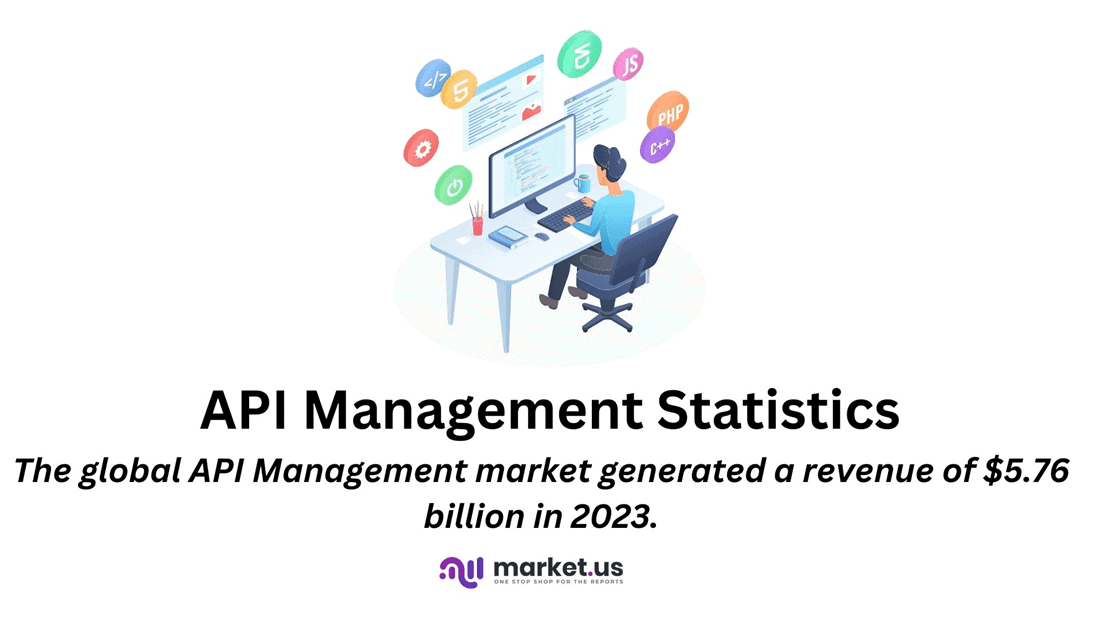
Editor’s Choice
- In 2023, the global API management market revenue stood at USD 5.76 billion.
- The global API management market is divided primarily between solutions and services, with a majority market share of 63.4%, while services represent the remaining 36.6%.
- According to the Salt Security report, 66% of companies acknowledge delaying deploying new applications into production due to concerns related to API security.
- Among professionals in any sector, 71% incorporate third-party APIs into their work, while a slightly lower but still significant percentage of 64% of hobbyists or students also utilize them.
- In 2020, allocating time for various application programming interface (API) tasks worldwide varied significantly, with coding and programming APIs occupying the most significant share at 29.5%.
- Internal APIs exhibit substantial current usage, with 94% of respondents already utilizing them, while only 4% have plans to use them, and a mere 2% have no plans.
- Among API documentation and inventory management mechanisms, Postman emerges as the most widely utilized tool, with 40% of respondents leveraging its capabilities.
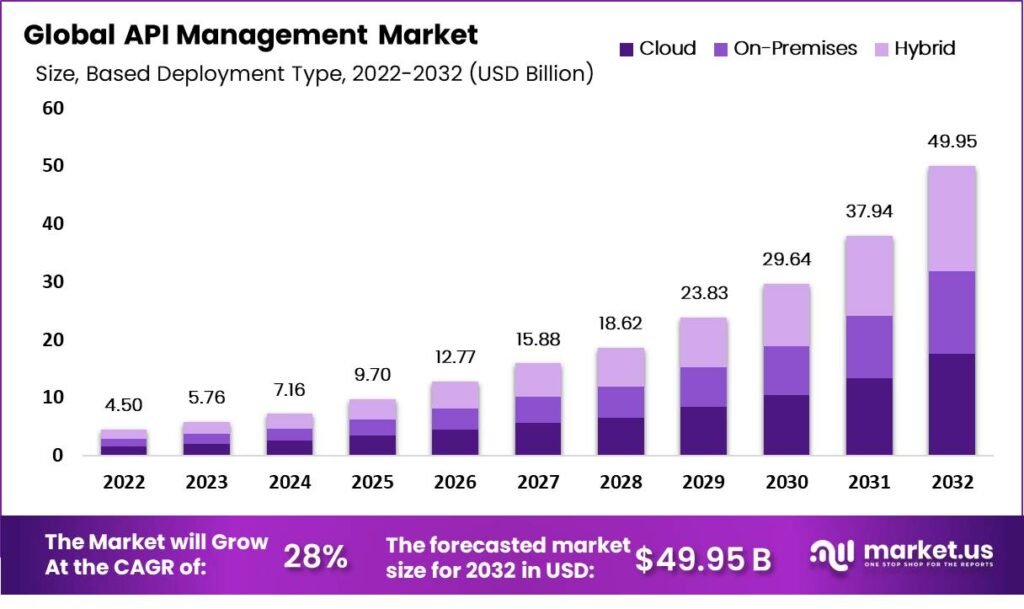
Global API Management Market Overview
Global API Management Market Size Statistics
- The global API management market has experienced significant growth in recent years at a CAGR of 28%, with revenues steadily increasing.
- In 2022, the market revenue stood at USD 4.50 billion, which rose to USD 5.76 billion in 2023.
- This upward trend is expected to continue, with projected revenues reaching USD 7.16 billion in 2024 and further climbing to USD 9.70 billion in 2025.
- Over the following years, the market is anticipated to witness even more substantial growth, with revenues forecasted to reach USD 12.77 billion in 2026 and USD 15.88 billion in 2027.
- By 2028, the market is projected to exceed USD 18.62 billion in revenue. Continuing its upward trajectory to reach USD 23.83 billion in 2029 and USD 29.64 billion in 2030.
- The growth momentum is expected to persist, with revenues estimated to soar to USD 37.94 billion in 2031 and surpass USD 49.95 billion by 2032.
- These figures underscore the increasing global demand for API management solutions, driven by the growing adoption of digital technologies and the rising importance of seamless connectivity and integration across diverse platforms and services.
(Source: Market.us)
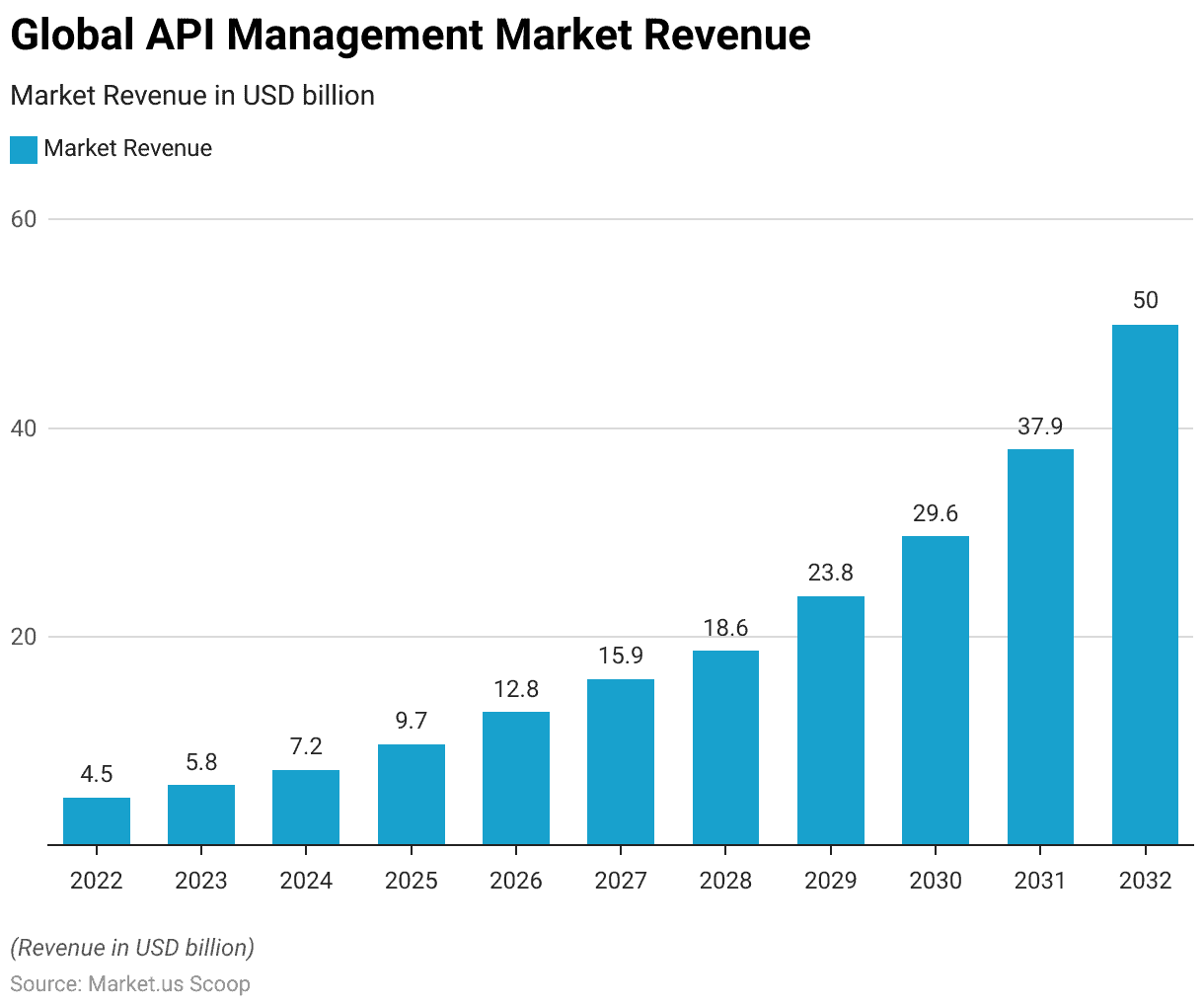
Global API Management Market Size – By Deployment Type Statistics
- The global API management market, categorized by deployment type, demonstrates a substantial expansion over the forecast period.
- In 2022, the total market revenue amounted to USD 4.50 billion, with on-premises deployment generating USD 2.16 billion, cloud deployment generating USD 1.8 billion, and hybrid deployment contributing USD 0.54 billion.
- This trend continued to escalate in subsequent years, with revenues reaching USD 5.76 billion in 2023, USD 7.16 billion in 2024, and USD 9.70 billion in 2025.
- The growth trajectory remained robust, with revenues climbing to USD 12.77 billion in 2026, USD 15.88 billion in 2027, and USD 18.62 billion in 2028.
- By 2029, the market revenue surged to USD 23.83 billion, escalating to USD 29.64 billion in 2030 and USD 37.94 billion in 2031.
- The trend culminated in a projected revenue of USD 49.95 billion in 2032. Throughout this period, both on-premises and cloud deployments witnessed steady growth, with hybrid deployment emerging as a significant contributor to the market.
- These figures underscore the increasing adoption of API management solutions across various deployment types, driven by the growing demand for seamless integration, scalability, and flexibility in managing digital assets and services.
(Source: Market.us)

Global API Management Market Share – By Component Statistics
- The global API management market is divided primarily between solutions and services, with a majority market share of 63.4%, while services represent the remaining 36.6%.
- This distribution emphasizes the significant presence of software solutions and services in addressing the needs of organizations for effective API management.
- Solutions encompass a wide array of tools and platforms tailored to facilitate the creation, deployment, monitoring, and optimization of APIs, enabling seamless integration and interaction across diverse systems and services.
- On the other hand, services are crucial in providing implementation, customization, and support services to ensure these solutions’ successful utilization and maintenance.
- Solutions and services are essential to the API management landscape, driving innovation, efficiency, and competitiveness in today’s digital-driven business environment.
(Source: Market.us)
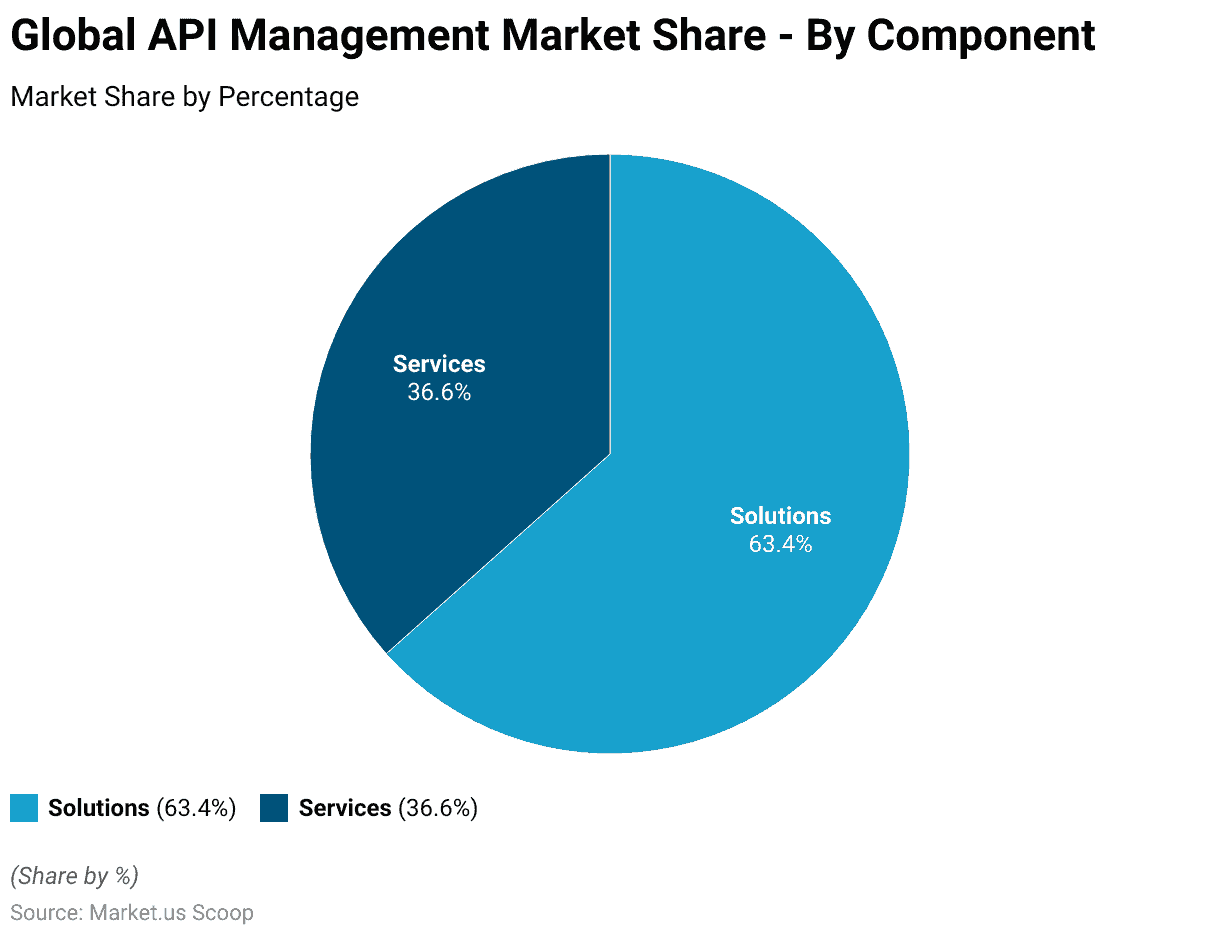
Factors Driving the Adoption of APIs
- Salt Security published a report titled “The State of API Security – Q1 2021,” disclosing significant insights regarding API security practices among organizations.
- According to the report, 66% of companies acknowledge delaying the deployment of new applications into production due to concerns related to API security.
- Moreover, the findings indicate that 54% of organizations operating production APIs possess, at most, a rudimentary approach to API security, while 27% lack any strategy altogether.
- These revelations underscore the prevalent challenges and gaps in API security measures within businesses, highlighting the urgent need for enhanced security protocols to safeguard against potential threats and vulnerabilities.
(Source: The State of API Security Report)
Take advantage of our unbeatable offer - buy now!

Popular Third-party API Categories
- Among developers who utilize third-party APIs, specific categories emerge as particularly popular.
- Location and mapping APIs are topping the list, with 37% of developers incorporating them into their projects, closely followed by payments APIs at 36%.
- Email and messaging APIs also boast significant usage, with 34% and 29% of developers integrating them into their applications.
- Social and search APIs share a similar level of popularity, each utilized by 29% of developers.
- Meanwhile, eCommerce, machine learning, video, and weather APIs exhibit slightly lower but notable adoption rates, with approximately 20% of developers employing each category.
- This data underscores the diverse array of third-party APIs developers leverage across different domains, highlighting their importance in enabling the functionality and features of contemporary applications.
(Source: Slashdata Developer Economics Survey 2019)
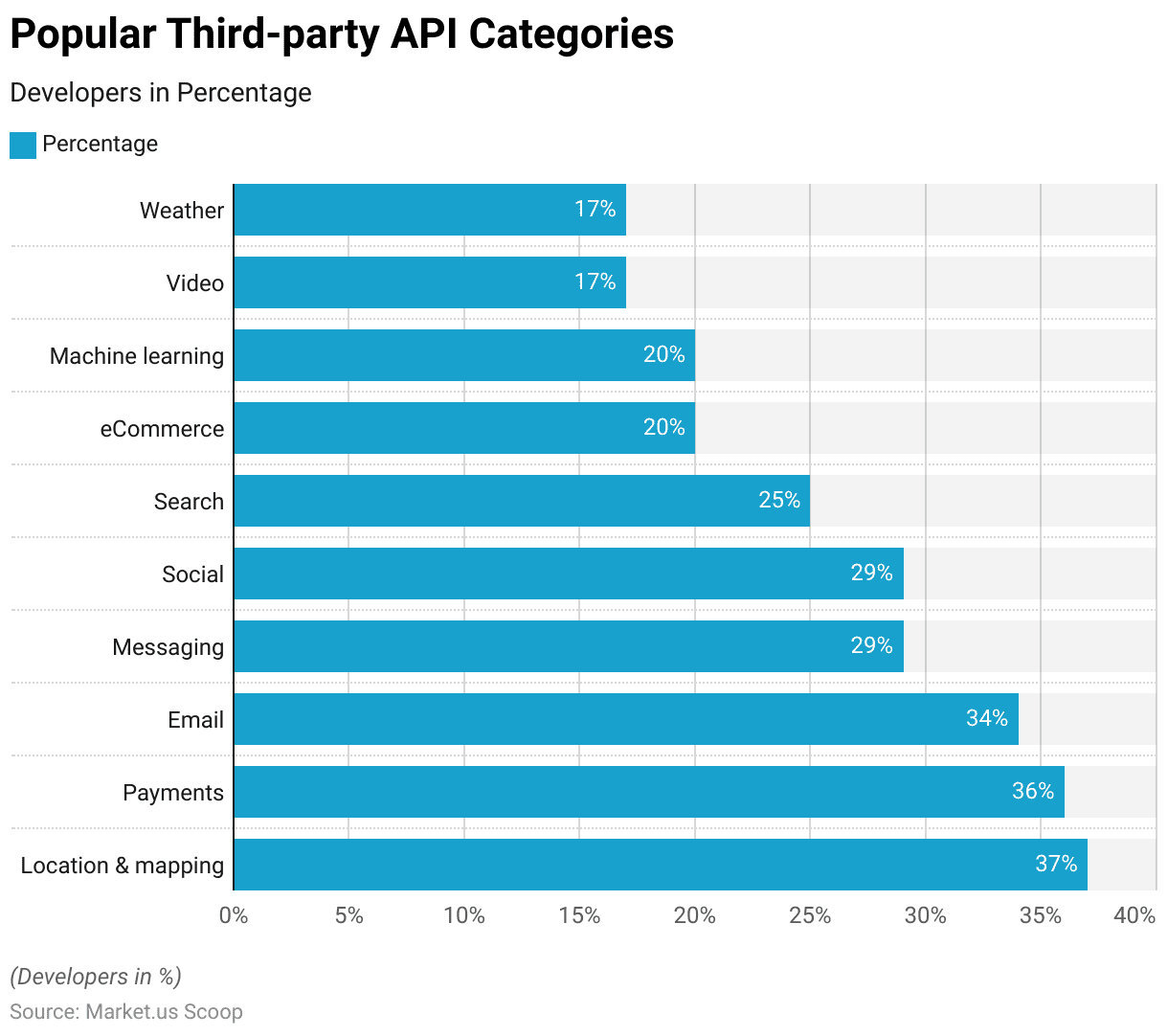
Usage of APIs by Professionals and Students
- The utilization of APIs varies between professionals across sectors and hobbyists or students, with most of both groups engaging with third-party APIs.
- Among professionals in any sector, 71% incorporate third-party APIs into their work, while a slightly lower but still significant percentage of 64% of hobbyists or students also utilize them.
- Private or internal APIs see less widespread use, with 22% of professionals and 16% of hobbyists or students leveraging them.
- Notably, a small percentage of professionals, accounting for 7%, do not use APIs, whereas a more significant proportion of hobbyists or students, totaling 20%, fall into this category.
- These findings illustrate the prevalent adoption of third-party APIs by professionals and students, underscoring their importance in various contexts while highlighting the comparatively lower usage of private/internal APIs and the significant number of hobbyists or students who do not utilize APIs at all.
(Source: Slashdata Developer Economics Survey 2019)
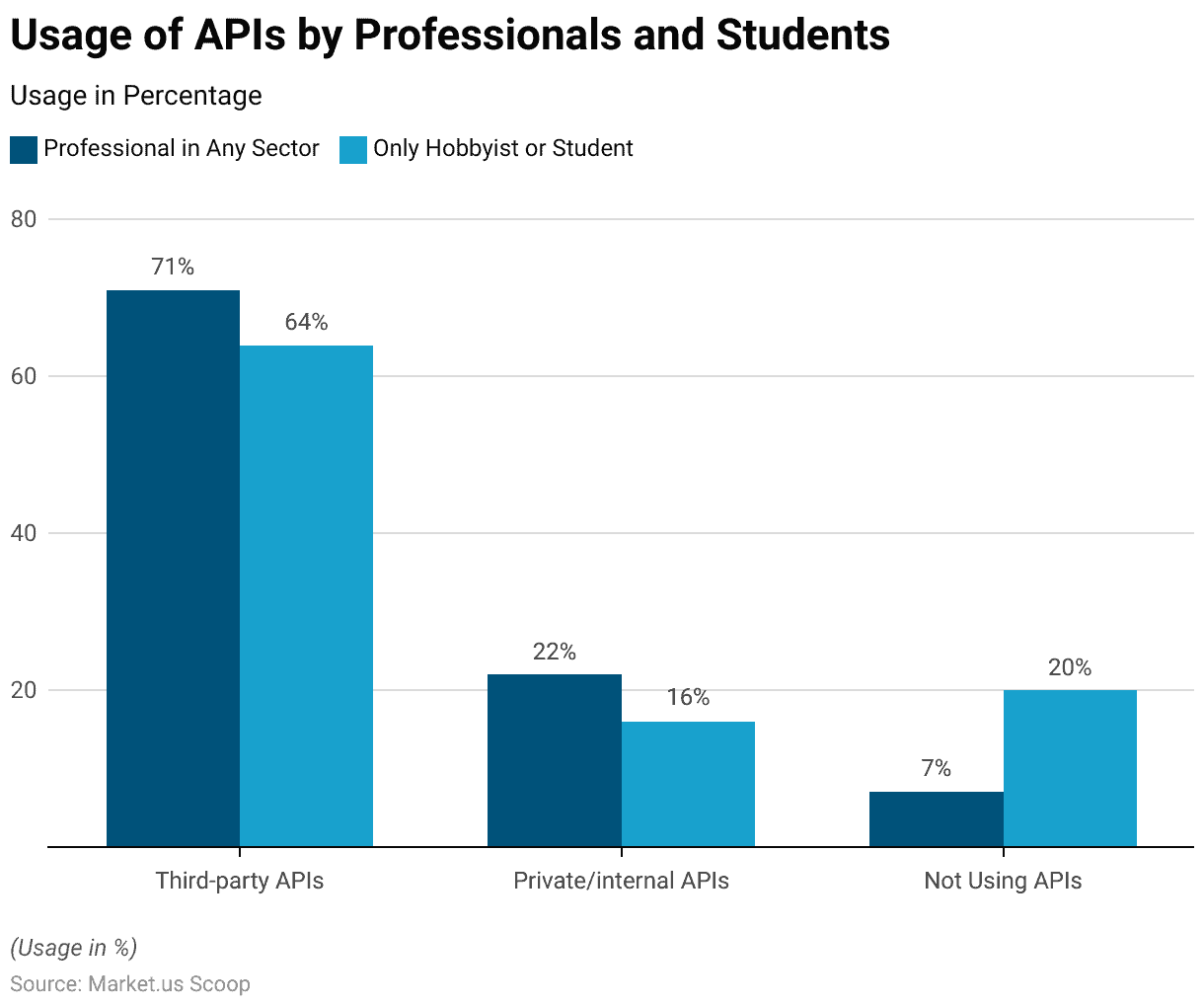
Time Allocation of API Tasks
- In 2020, allocating time for various application programming interface (API) tasks worldwide varied significantly, with coding and programming APIs occupying the most significant share at 29.5%.
- Following closely behind was debugging and manual testing, accounting for 17% of respondents’ time allocation.
- Automated testing and designing/mock APIs also commanded notable shares, with 10.8% and 8.7%, respectively.
- The task of API documentation accounted for 6.1% of respondents’ time while managing others who use APIs and attending meetings about APIs, which represented approximately 5.8% and 5.7%, respectively.
- Collaboration on APIs accounted for 4.9% of the time, while API monitoring and publishing APIs occupied 4.3% and 2.5%, respectively.
- Additionally, managing API artifacts and writing about APIs comprised 2.5% and 2.2% of respondents’ time allocation.
- These findings provide valuable insights into the distribution of efforts and priorities in API-related tasks, highlighting the diverse activities involved in API development, management, and maintenance.
(Source: Statista)
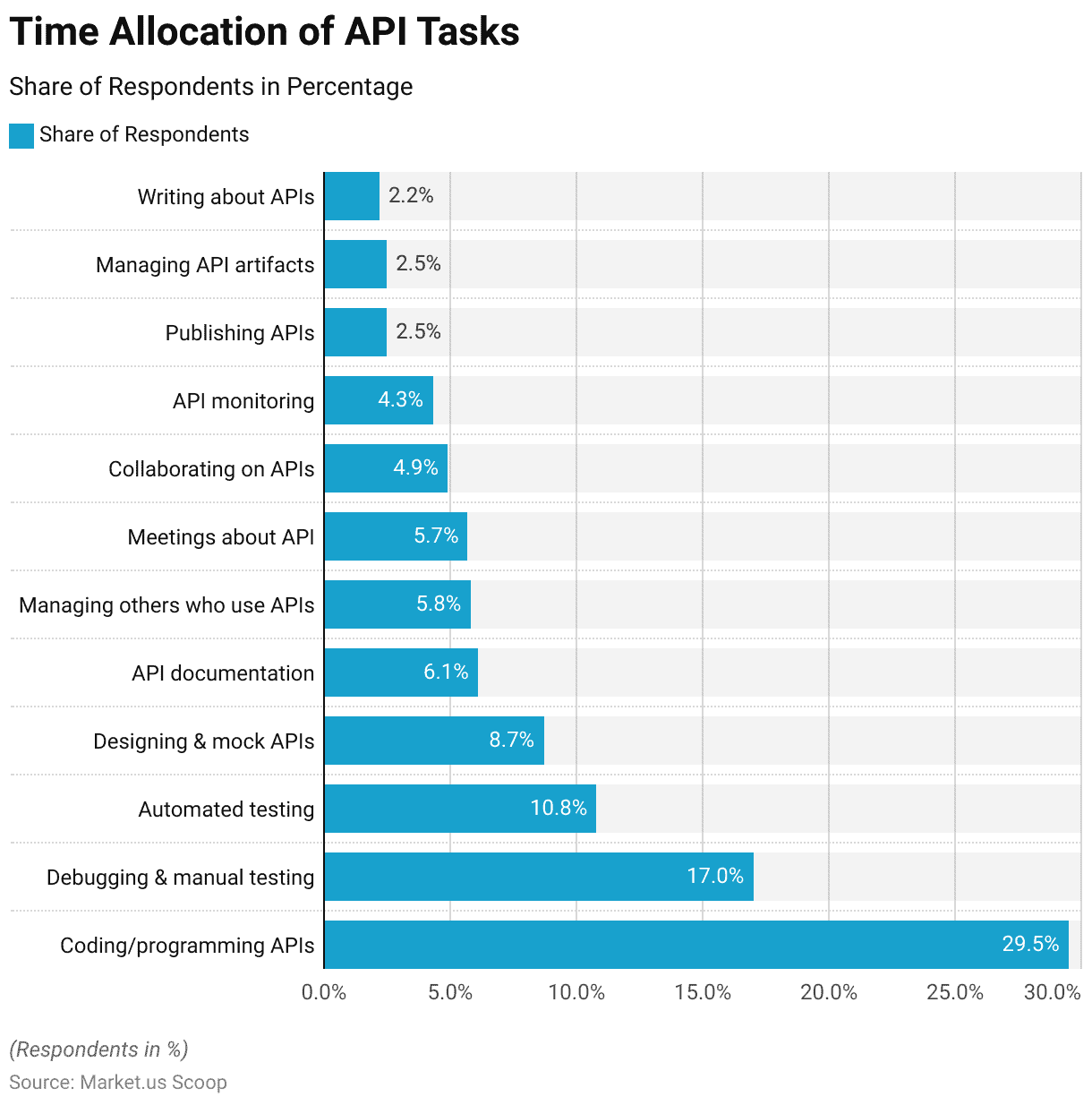
Areas Where API Developers Work
- In 2022, application programming interface (API) developers work across various professional roles worldwide, with a diverse distribution among job titles.
- Full stack developers constitute the most significant % of respondents at 25%, followed by backend developers at 19%.
- Quality engineers, responsible for ensuring the reliability and effectiveness of APIs, account for 9% of respondents, while frontend developers represent 5%.
- Technical and solutions architects make up 4%, alongside individuals in direct managerial positions. Integration engineers and DevOps engineers each contribute 3% to the workforce.
- Notably, students and professors also engage in API development, comprising 3% of respondents.
- Data engineers and analysts, product managers, and individuals in roles such as CTO, business analyst, mobile developer, support or customer success, CEO, sales or solutions engineer, network engineer, security engineer, VP of engineering, and other miscellaneous positions each represent smaller yet significant shares of approximately 2% or less.
- These findings reflect the diverse range of professionals involved in API development across different domains and specialties, highlighting the interdisciplinary nature of API-related work in the global workforce.
(Source: Statista)
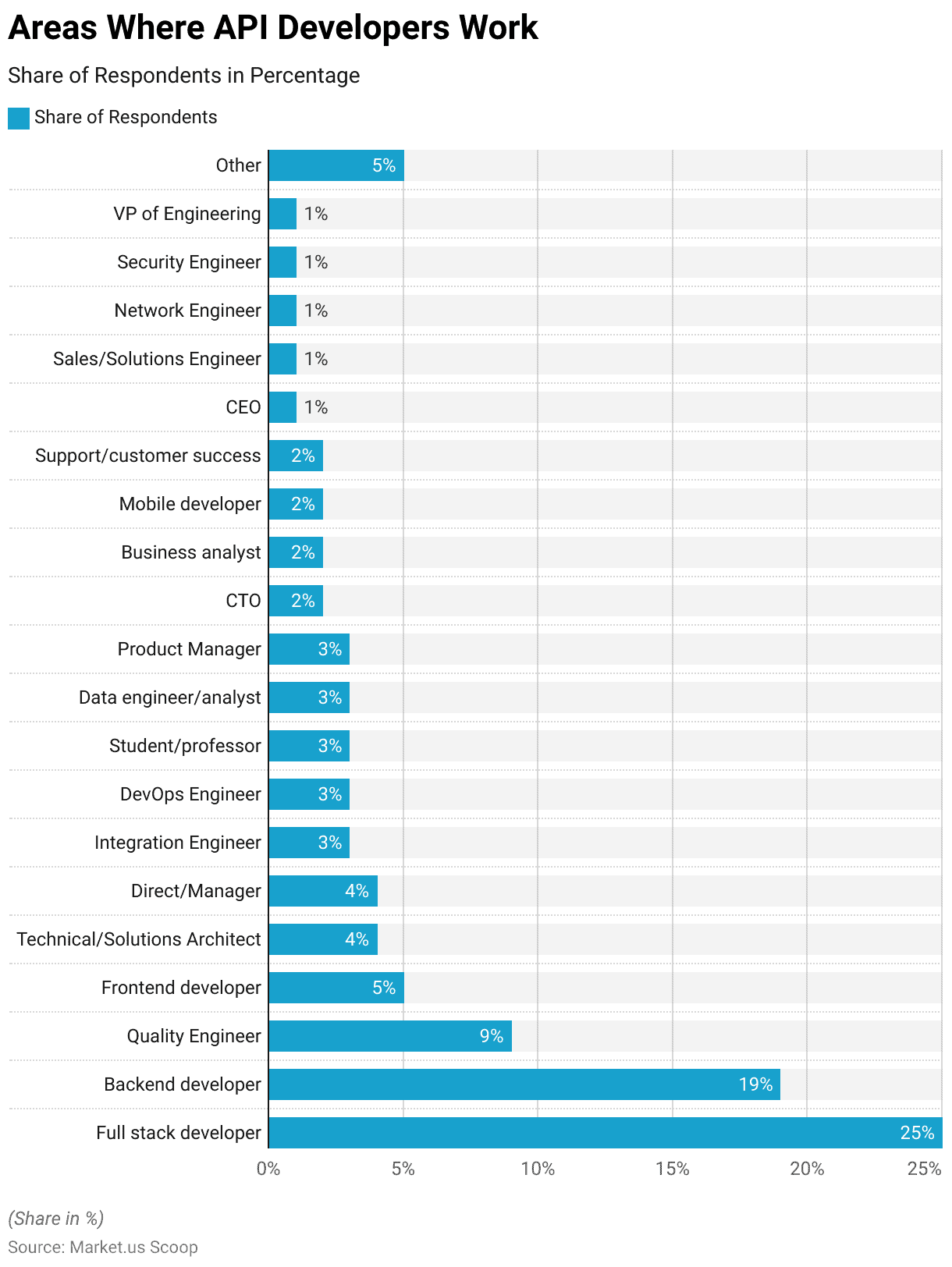
Current Use of APIs and Key Predictions
- When considering different types of APIs, the data from respondents reveals varied plans and usage patterns.
- Internal APIs exhibit substantial current usage, with 94% of respondents already utilizing them, while only 4% have plans to use them, and a mere 2% have no plans.
- Conversely, APIs provided by third parties show a significant level of current usage at 82%, with 12% planning to use them and 6% having no plans.
- Private APIs for connecting with other businesses or networks display a similar trend, with 73% currently using them, 17% planning to do so, and 10% having no plans.
- In contrast, public or externally exposed APIs demonstrate lower current usage, with 67% utilizing them, while 12% plan to use them, and 20% have no plans.
- These findings underscore the prevalent adoption of internal and third-party APIs while highlighting a lower adoption rate for private and public APIs, indicating differing priorities and strategies among respondents.
(Source: Gartner)
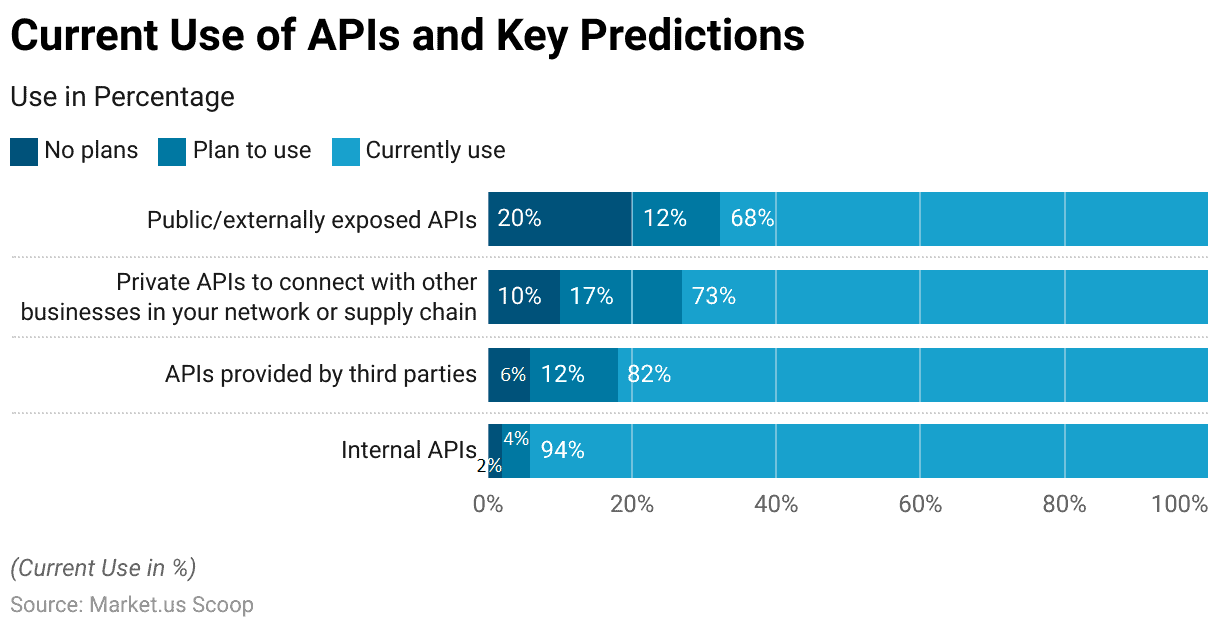
Mechanisms Used for API Document and Inventory
- As revealed by the survey, various mechanisms are employed for API documentation and inventory management.
- Among these, Postman emerges as the most widely utilized tool, with 40% of respondents leveraging its capabilities.
- Swagger follows closely behind, with a usage rate of 28%, while OpenAPI Generator is utilized by 20% of respondents.
- Application scanning and API management platforms are also popular, with 23% and 34% adoption rates, respectively.
- Configuration management databases are utilized by 18% of respondents.
- Additionally, Redoc and DapperDox contribute to the landscape, with 8% and 4% usage rates, respectively.
- Other mechanisms collectively make up 8% of the usage.
- These findings underscore the diverse array of tools and platforms available for API documentation and inventory management, catering to developers’ and organizations’ varied needs and preferences in the API ecosystem.
(Source: State of API Security Report)
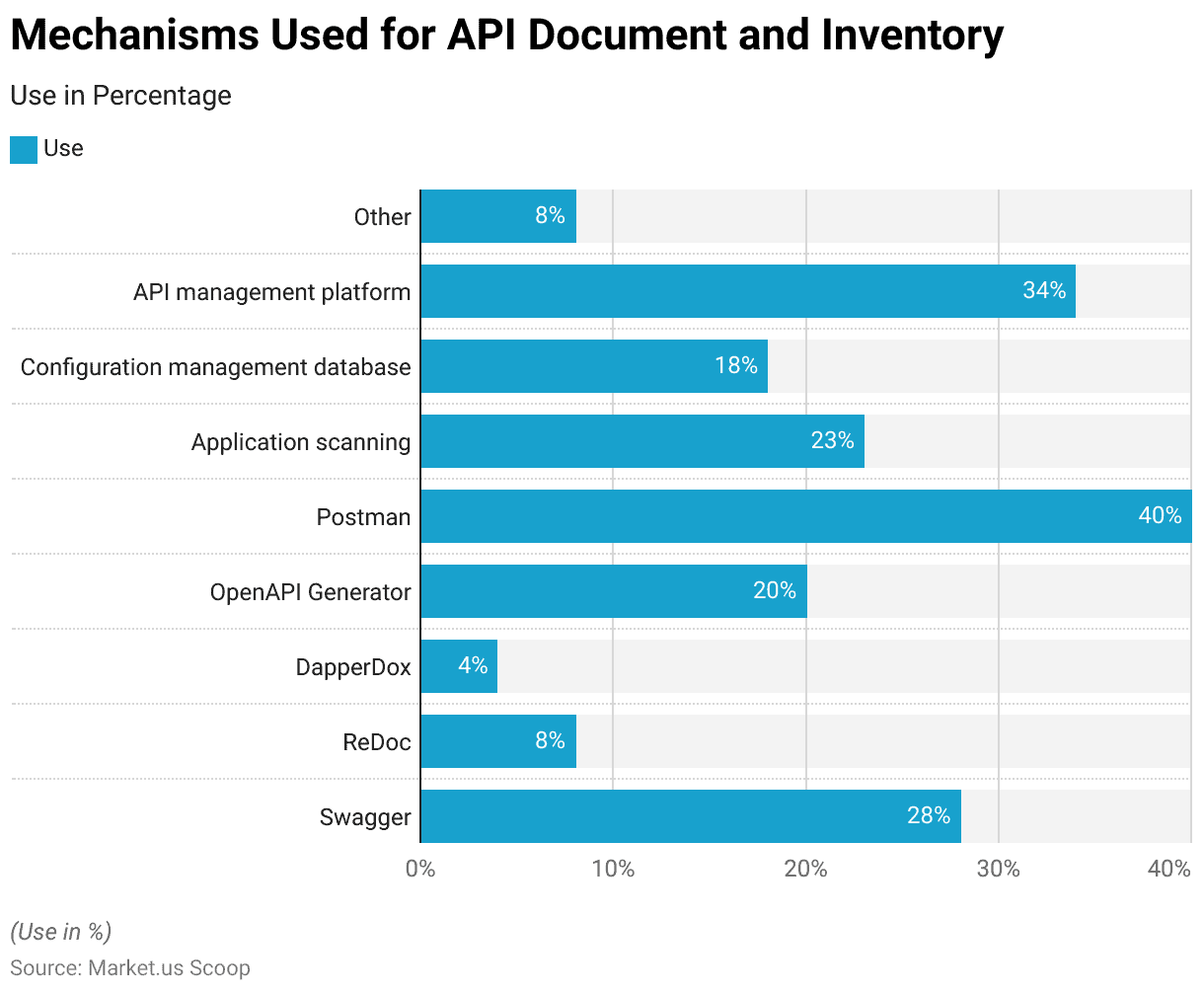
Issues in API Integration Management Statistics
- Issues in API integration are a significant concern among respondents, with improper authentication, authorization, or access control being the most prevalent at 30%.
- This is followed by insecure data leaks or exposure. Accounting for 17% of respondents’ concerns, and business logic issues, which constitute 16%.
- Additionally, insufficient logging and monitoring are cited by 12% of respondents as a significant issue. While inadequate access control and denial-of-service (DoS) attacks each represent 8%.
- Injection attacks, such as SQL injection, are reported by 5% of respondents as problematic.
- Interestingly, 3% of respondents express uncertainty about the whereabouts of all their APIs, indicating a potential gap in API management practices.
- These findings underscore the multifaceted challenges associated with API integration, ranging from security vulnerabilities to issues related to visibility and control over API usage and infrastructure.
(Source: Postman Survey)
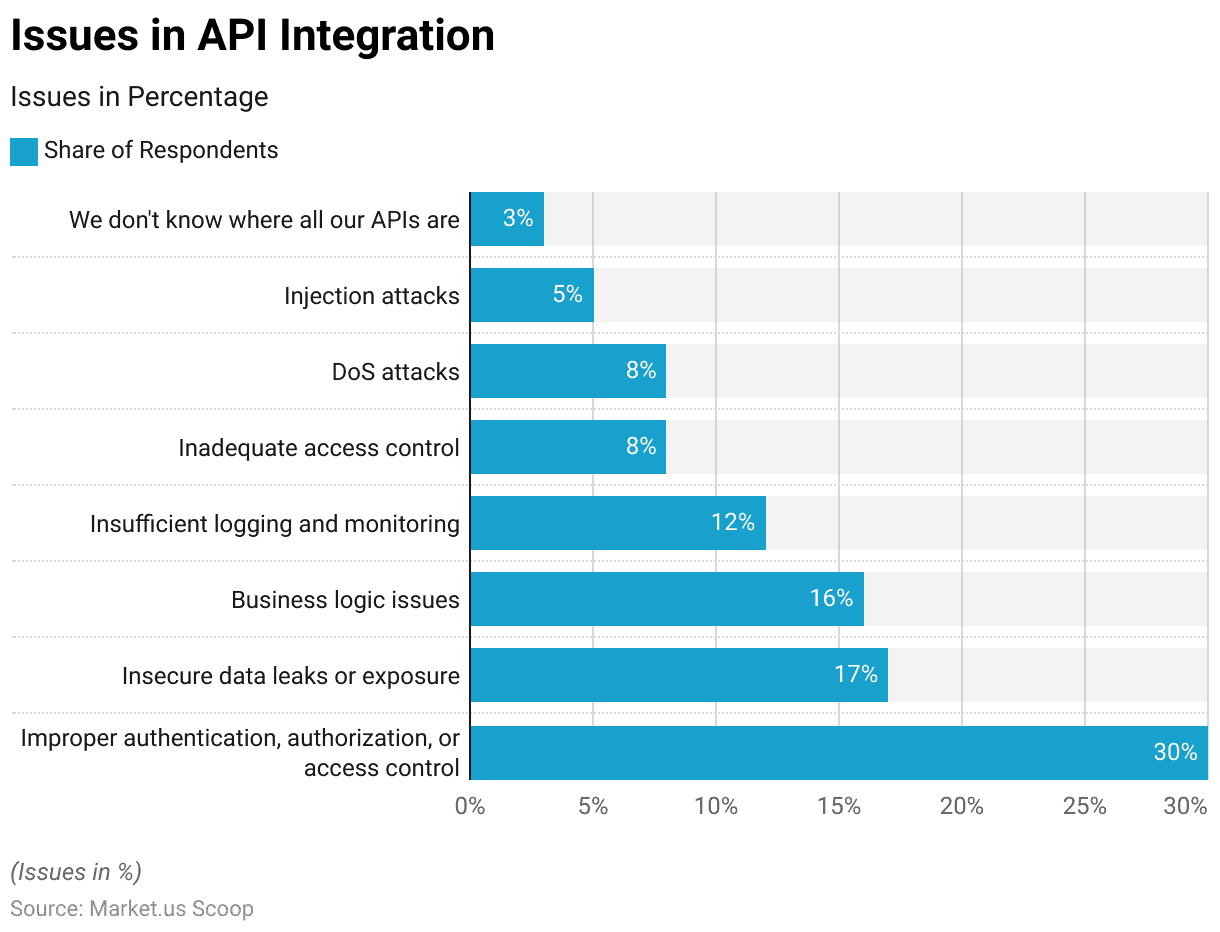
API Management Statistics by Technological Advancements
- As of 2020, professionals working with application programming interfaces (APIs) worldwide find several technologies particularly exciting.
- Microservices top the list, with 48.70% of respondents expressing enthusiasm, followed closely by Kubernetes at 43.60% and containers at 42.20%.
- Serverless architecture also garners significant interest, with 39% of respondents finding it compelling.
- Additionally, GraphQL, known for its efficient data querying capabilities, captures the attention of 33.40% of respondents.
- The adoption of HTTP/2, offering improved performance and efficiency, is noted by 24.70% of respondents. While event-driven architecture, facilitating real-time data processing, resonates with 24.10% of respondents.
- Pub/sub (publish/subscribe) architecture, supporting scalable and decoupled communication between components, attracts 17.40% of respondents.
- Finally, service mesh technology, aimed at managing communication between microservices, is of interest to 9.90% of respondents.
- These findings underscore the diverse array of technologies shaping the landscape of API development and integration, reflecting the industry’s ongoing pursuit of efficiency, scalability, and innovation.
(Source: Statista)
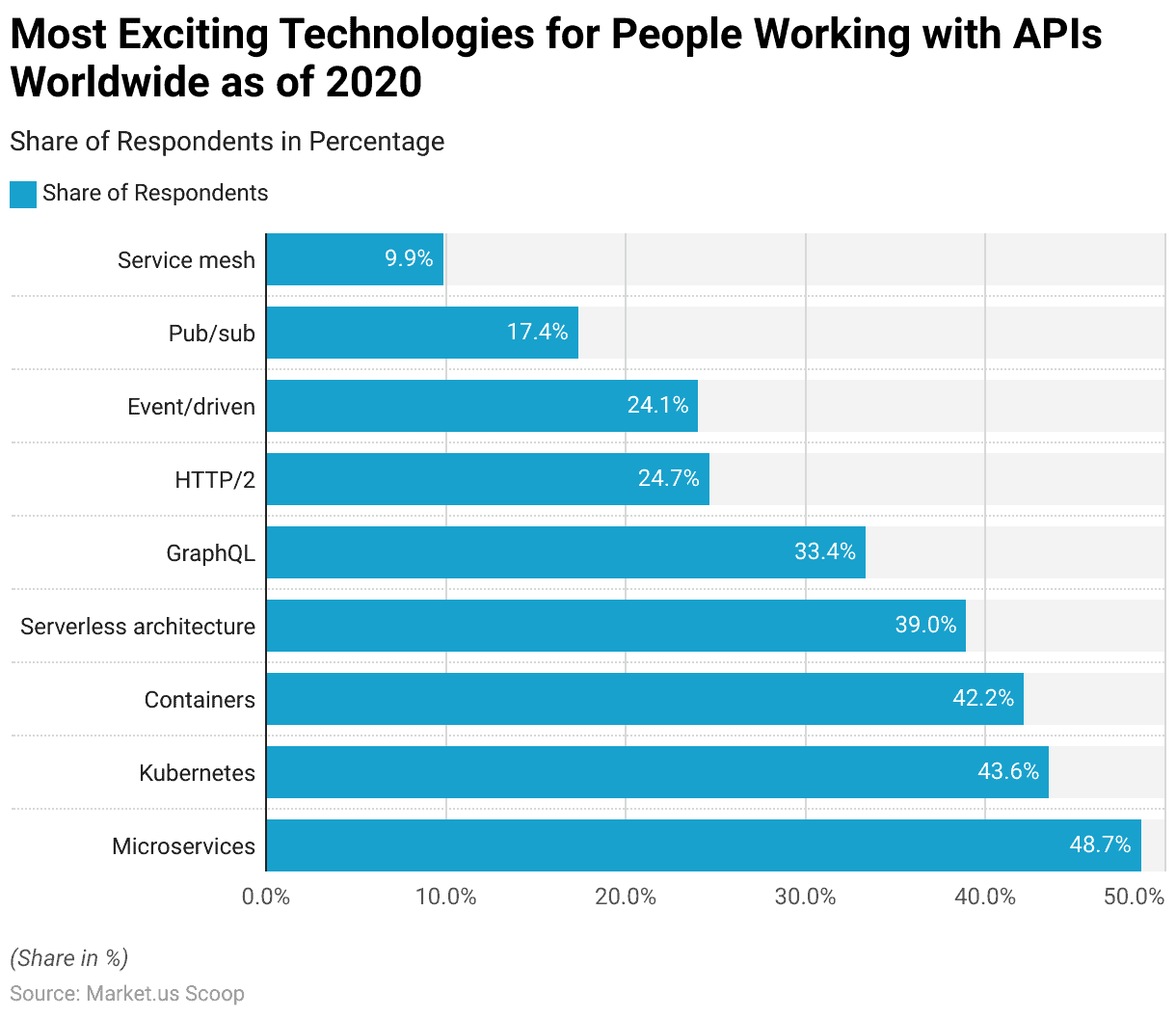
Conclusion
API Management Statistics – In summary, managing APIs is vital for organizations navigating the digital realm. It involves implementing methods, tools, and plans to regulate and safeguard APIs, promoting innovation and productivity.
The market analysis underscores an increasing demand for API management solutions driven by initiatives for digital transformation. However, security issues persist, highlighting the importance of solid governance and monitoring.
Despite these challenges, emerging technologies like microservices offer fresh prospects for scalability and flexibility. Effective API management isn’t just advisable but essential for organizations to flourish in the digital era, harnessing APIs’ full potential for sustainable development.
FAQs
API management involves the governance, optimization, and security of APIs throughout their lifecycle, from creation to retirement. It includes practices, tools, and strategies to ensure that APIs are effectively utilized and secure.
API management is crucial for organizations to leverage APIs in their digital initiatives effectively. It enables seamless integration, ensures security, promotes collaboration, and drives innovation, ultimately enhancing operational efficiency and customer experiences.
Critical components of API management include API gateways, developer portals, lifecycle management, security measures, analytics, policy enforcement, integration capabilities, and documentation tools.
The benefits of API management include accelerated innovation, increased agility, enhanced customer experiences, improved operational efficiency, better collaboration, and the ability to capitalize on monetization opportunities.
Common challenges in API management include security concerns (such as improper authentication or data exposure), complexity in managing APIs across diverse environments, ensuring compliance with regulations, and the need for effective governance and monitoring.
Discuss your needs with our analyst
Please share your requirements with more details so our analyst can check if they can solve your problem(s)



